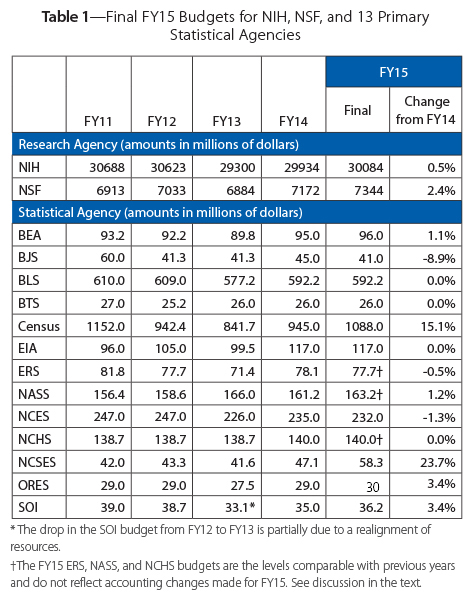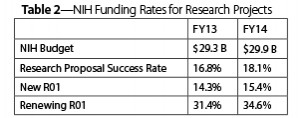FY15 Budgets for NIH, NSF, Federal Statistical Agencies Finalized
Issues to watch include ACS, reauthorizations, new leadership
Steve Pierson, ASA Director of Science Policy
The Senate extended its adjournment date for the 113th Congress to finalize the fiscal year 2015 (FY15) budgets for most of the federal government. (The Department of Homeland Security is on another continuing resolution through February.) One of the few bright spots was NSF, which received a 2.4% increase over its FY14 budget.
NIH and NSF
The NIH received an FY15 budget of $30.1 billion, which is a half percent above its FY14 level and means NIH loses purchasing power due to inflation. In addition to the $30.1 billion, the NIH received $240 million for Ebola research funding. For an indication of what this level might mean for proposal success rates, consider how the FY14 proposal success rates fared with a 2% increase over the FY13 level (Table 2). For a more in-depth analysis of the FY15 NIH budget, see the links in the blog entry. (e.g., from Science and COSSA).
The FY15 NSF budget is $7.3 billion. Besides the bill providing an increase maintaining NSF’s purchasing power, the bill had good news for what it didn’t include: a cut for the Social, Behavioral, and Economic (SBE) Sciences Directorate. The House science committee had passed a bill that would have cut the SBE budget by 40% and was determined to see at least some of that cut realized in the appropriations process. The bill did, however, specify that none of the increase could be provided to the Geosciences Directorate or SBE Directorate. The bill also directs NSF to increase its funding of the BRAIN initiative by $21 million. For FY14, the overall NSF proposal funding rate was 23%, up a percentage point from FY13, but below the FY12 level of 24%.
Federal Statistical Agencies
The U.S. Census Bureau and its stakeholders received both good and disappointing news. Its budget was increased 15% for the ramp up to the 2020 decennial census, but this level is $123 million short of its requested level. As a result, the Census Bureau will likely have to scale back significantly the planned testing for FY15, which could potentially add to the overall price tag for the 2020 census. The good news is that the final bill does not include a House provision to make the American Community Survey (ACS) voluntary. For further commentary on the FY15 Census Bureau budget, follow the links in the blog entry.
The Bureau of Labor Statistics (BLS) was flat funded at $592 million from FY14, which will likely mean more difficult cuts for BLS. Because budget is 3% below its FY10 and FY11 levels—more than 10% lower taking into account inflation—it already has cut many surveys in the last few years. To prevent further cuts, advocates were hoping a modest increase for FY15.
The budget for the Bureau of Justice Statistics (BJS) was cut 9% to $41 million.
The Economic Research Service (ERS) budget went up on paper to $85.4 million, but $7.7 million was for USDA accounting changes, so the level reported in Table 2 is comparable with the FY14 and prior levels. Similarly for the National Agricultural Statistics Service (NASS), its budget went up 7%, but subtracting the increase of $9.2 million for accounting changes, it sees a 1% increase.
The National Center for Health Statistics (NCHS) also underwent accounting changes—the establishment of a Working Capital Fund to cover costs previously covered by the CDC—that see its budget increase to $155.4 million. In FY14 comparable values, however, it is flat-funded at $140 million. (For the policy wonks, the NCHS budget was switched from being funded by the TAP Evaluation fund to a direct appropriation.)
The Bureau of Economic Analysis (BEA) also is likely to be affected negatively by its 1% increase because it has sought an additional $8 million for FY15 to cover relocation and renovation expenses.
Thanks in part to the increase for NSF overall, the budget for the National Center for Science and Engineering Statistics (NCSES) increased to $58 million, much of which will be used to enhance the Survey of Doctorate Recipients.
The other federal statistical agencies generally see their budgets kept flat: Energy Information Administration (EIA), National Center for Education Statistics (NCES), and the Internal Revenue Service Statistics of Income Division (SOI).
The Bureau of Transportation Statistics (BTS) is funded through the Highway Trust Fund, so is not part of the appropriations process. It is due to be reauthorized for the next several years this spring.
The level for the Social Security Administration Office of Research, Evaluation, and Statistics (ORES) was not available as of the writing of this article.
Issues to Watch in New Congress
The budgets for NIH, NSF, and the federal statistical agencies will likely be largely flat for FY16 with sequestration limits back in place. The mandatory requirement of the ACS also will be an issue in both the appropriations and authorization process with the Republicans in control of the Senate and new committee chairs in the House. The chair of the House Oversight and Government Reform Committee, Jason Chaffetz (R-UT), was a cosponsor of a bill to make the ACS voluntary and a bill to eliminate almost all the Census Bureau’s programs except for the decennial census. The chair of the House appropriations panel that determines the Census Bureau budget, John Culberson (R-TX), also sponsored the voluntary ACS bill. The new chair of the Senate committee with oversight of the Census Bureau, Sen. Ron Johnson (R-WI), asked a number of questions about the ACS during an oversight hearing last year, but is not a cosponsor of the Senate voluntary ACS bill introduced by Sen. Rand Paul (R-KY).
Congress also will take up NSF reauthorization again. In the 113th Congress, the House and Senate NSF reauthorization bills were very different. The House version championed by Lamar Smith (R-TX), chair of the House science committee, would have mostly flat-funded NSF, cut the SBE directorate by 40%, and added requirements for the funding of awards. Sen. Jay Rockefeller (D-WV), then chair of the Senate science committee, introduced a bill that had generous increases for NSF and was supportive of SBE and NSF’s merit review process. It’s not clear where the new chair of the Senate science committee, Sen. John Thune (R-SD), stands on the issue.
The House also is likely to take up a science committee bill it passed in 2014 called the Secret Science Reform Act. The bill prohibits the Environmental Protection Agency from issuing any new regulations unless the underlying scientific and technical information is publicaly available to the extent allowed by law. ASA President David Morganstein wrote to House leadership in September expressing major concerns with the bill for its disregard of confidentiality agreements and, more generally, scientific complexities. Several senators introduced a companion bill that was not advanced. The bill was broadly opposed by the scientific community.
In the authorizations process, the ASA will be watching closely the reauthorization of the Department of Education Institute of Education Sciences (IES), under which sits NCES and three research centers. In the 113th Congress, the House passed an IES reauthorization bill that would have weakened NCES by transferring appointment of its commissioner from the president to the IES director and transferring some NCES responsibilities to IES. With the Senate Health, Education, Labor, and Pension Committee rubber-stamping the bill in September, it was widely expected that both chambers would approve the bill in the lame-duck Congress, but the concerns of a few senators for federal funding of education research is believed to have precluded the bill becoming law.
It also is possible that heads of BJS and NCES will be appointed early in the new Congress. BJS has had an acting director since December 2012 and NCES since late 2013. As of 2012, these positions no longer require Senate confirmation. SOI also is expected to name its new director early in 2015.












The FY16 budget request has been released and you can view the details and subsequent developments at FY16 NSF and NIH Budget Developments and FY16 Statistical Agency Budget Developments
Any news on funding for AHRQ (Agency for Healthcare Research and Quality)?
To see the President’s FY16 budget requests, see these blog entries: FY16 NSF and NIH Budget Developments and FY16 Statistical Agency Budget Developments.
Welcome!
Amstat News is the monthly membership magazine of the American Statistical Association, bringing you news and notices of the ASA, its chapters, its sections, and its members. Other departments in the magazine include announcements and news of upcoming meetings, continuing education courses, and statistics awards.
ASA HOME
Departments
Archives
ADVERTISERS
PROFESSIONAL OPPORTUNITIES
FDA
US Census Bureau
Software
STATA
QUOTABLE
“ My ASA friendships and partnerships are some of my most treasured, especially because the ASA has enabled me to work across many institutional boundaries and
with colleagues from many types of organizations.”
— Mark Daniel Ward
Editorial Staff
Managing Editor
Megan Murphy
Graphic Designers / Production Coordinators
Olivia Brown
Meg Ruyle
Communications Strategist
Val Nirala
Advertising Manager
Christina Bonner
Contributing Staff Members
Kim Gilliam
Contact us
Amstat News
American Statistical Association
732 North Washington Street
Alexandria, VA 22314-1904
(703) 684-1221
www.amstat.org
Address Changes
Amstat News Advertising